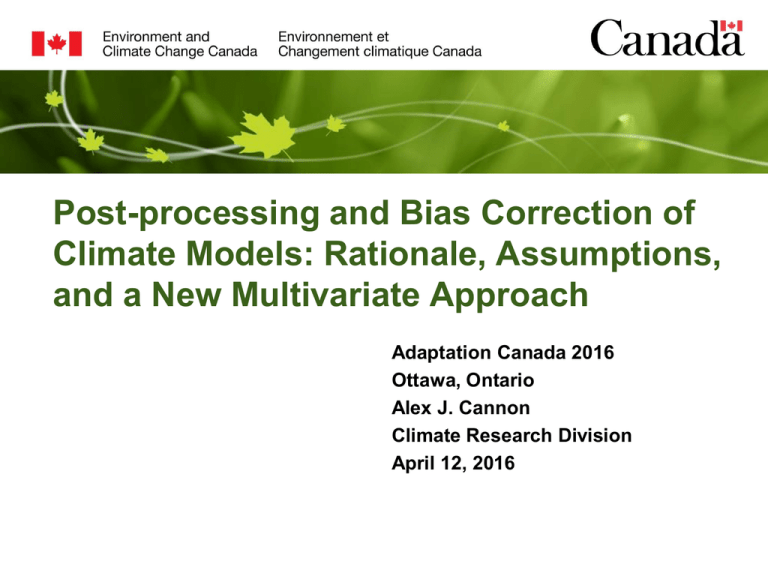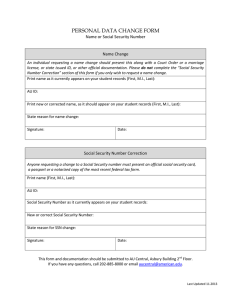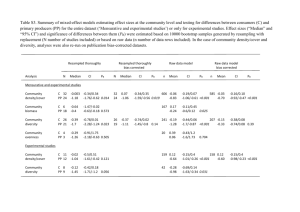Post-processing and Bias Correction of Climate Models: Rationale
advertisement

Post-processing and Bias Correction of Climate Models: Rationale, Assumptions, and a New Multivariate Approach Adaptation Canada 2016 Ottawa, Ontario Alex J. Cannon Climate Research Division April 12, 2016 Overview • What is post-processing? What is bias correction? – definitions • Why do we need to post-process climate models? – fitness for purpose • What kinds of errors can be corrected? – Eden et al. (2012) three types • How model outputs are bias corrected matters… • Case studies – GCM annual maximum precipitation – RCM Canadian Fire Weather Index Page 2 – April-20-16 What is post-processing? Bias-correction? • Adjusting model-simulated quantities to make them correspond more closely to reference data – – – – – bias-correction (systematic errors) statistical downscaling (differences in spatial scale) temporal disaggregation (differences in temporal scale) calibration (reliable estimates of conditional probability) estimation of variables that aren’t directly simulated • Adjusting model-simulated quantities to remove systematic errors relative to reference data Page 3 – April-20-16 Correcting biases in… – single variable: mean, variance, shape of distribution… – multiple variables: dependence structure Quantile mapping Other characteristics… Obs. - autocorrelation - seasonal cycle - etc. Climate model shift and scale Model Page 4 – April-20-16 Observed Observations and reference data • Impacts and adaptation researchers typically have a historical reference dataset – in situ observations, observationallyconstrained gridded fields, model outputs, etc. – that is being used as “truth”, irrespective of its errors and inaccuracies historical observations - assume stationarity historical simulations future projections Page 5 – April-20-16 Why do we need bias correction? • fitness for purpose • simple example threshold exceedances No. days > 1-mm precip. Climate model No. days > 25⁰C Tmax Historical observations Page 6 – April-20-16 What kinds of errors can be corrected? • Eden et al. (2012) classify errors in climate model outputs into three categories: 1. unrealistic large-scale variability or response to climate forcings; 2. unpredictable internal variability that differs from observations; 3. parameterizations and unresolved subgrid-scale orography, etc. Page 7 – April-20-16 How model outputs are bias corrected matters… Knobs, trade-offs, and unintended consequences Climate model Page 8 – April-20-16 temporal sequencing Inter-variable dependence marginal distributions Observations … Case study #1: daily precipitation Unintended consequences… GCM hist Quantile mapping QDM Obs GCM future corrected hist corrected future x3 Cannon et al. (2015, J. Climate) Page 9 – April-20-16 Quantile delta mapping Case study #2: Fire Weather Index (FWI) Handling multiple variables… Canadian Forest Fire Weather Index system is a complicated set of linked indices featuring nonlinear dependence on current and past values of 24-hr precipitation 2-m relative humidity 10-m wind speed 2-m temperature at 12:00 LST Developed at NRCan CFS - global standard - future projections of FWI? Page 10 – April-20-16 Alexander & De Groot (1998, NRCan CFS) Page 11 – April-20-16 Canadian Regional Climate Model • NAM-44i North American domain (0.5 x 0.5-deg) • 3-hr outputs or pr, tas, huss, sfcWind, ps, rsds, rlds 1. raw CanRCM4 outputs 2. univariate correction of each variable separately 3. multivariate bias correction of all variables simultaneously Cannon (submitted, J. Climate) Calculate and compare FWI and its sub-indices CanRCM4 ERA-Interim evaluation run two-fold cross-validation (1989-1999; 2000-2009) WFDEI meteorological forcing data set observational target Page 12 – April-20-16 CanRCM4 bias correction Page 13 – April-20-16 Conclusions • Be aware that bias correction algorithm matters – – – – • • • • What exactly is being corrected and what is not? Where is the climate model providing information? Does dependence between variables matter? Is the climate change signal being corrupted artificially? Be sure the method is fit for the purpose intended Be aware of assumptions (and if they are being violated) Be explicit about how the “knobs” are set Beware of unintended consequences Page 14 – April-20-16 Thank you… Page 15 – April-20-16

